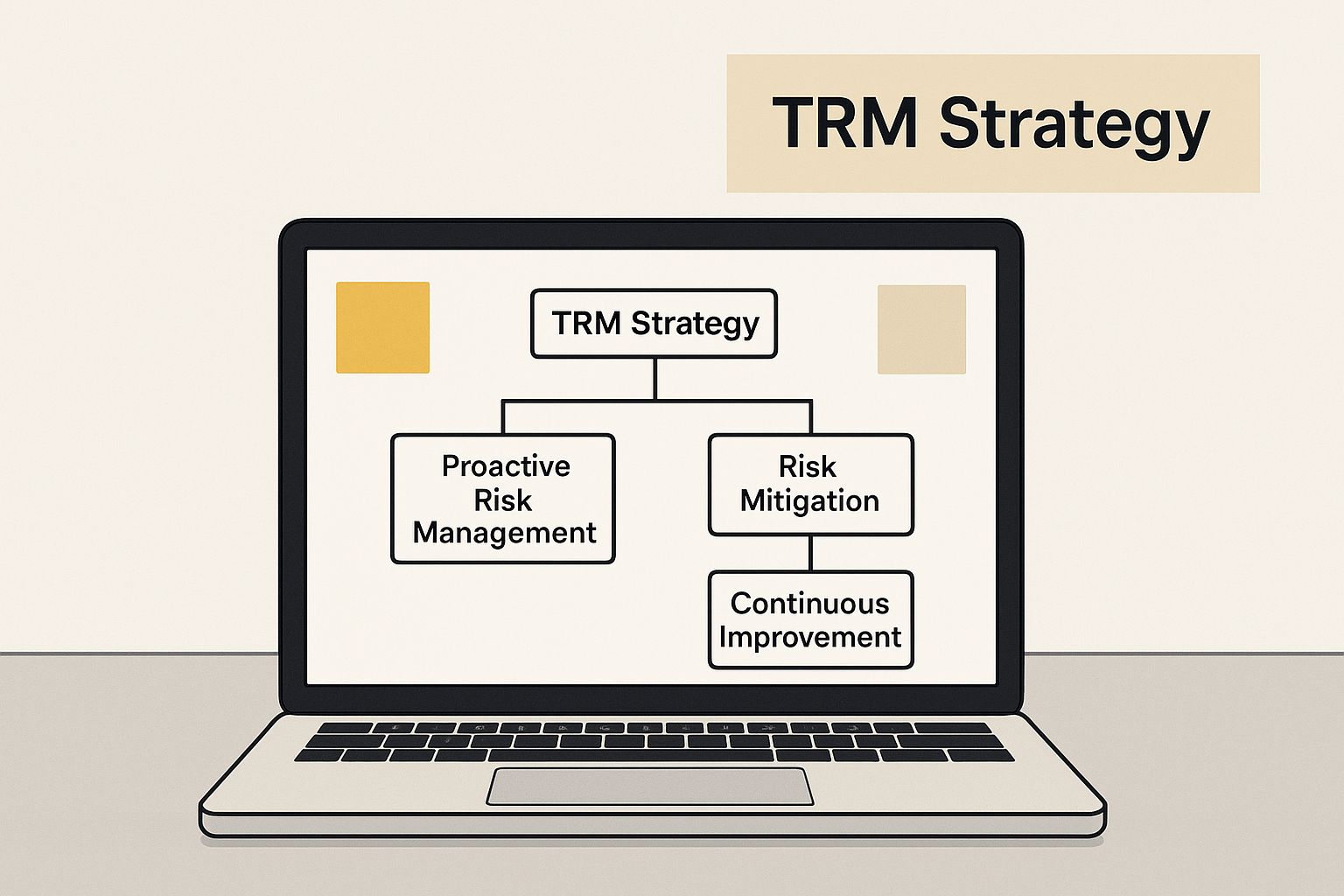Mastering Talent Relationship Management
- Janis Kolomenskis
- Oct 12
- 14 min read
Let’s be honest, the old way of hiring is broken. That frantic scramble every time a new position opens? The "post and pray" method that leaves you drowning in a sea of irrelevant CVs? It just doesn’t work anymore.
Talent Relationship Management, or TRM, is the antidote to that chaos. It's about flipping the script entirely.
Instead of waiting for a need and then starting from scratch, TRM is all about proactively building a community of skilled professionals who already know you, like you, and are genuinely interested in what you're doing. It’s a complete mindset shift from reactive filling of seats to strategic community building.
Why Talent Relationship Management Is Your New Hiring Superpower
Think of traditional recruiting like going to the supermarket only when you're starving. You end up grabbing whatever's on the shelf, not necessarily the best ingredients.
TRM, on the other hand, is like tending your own garden. You plant seeds, nurture them over time, and build relationships with your future star players long before you even have a role for them. When the time comes, you don't have to go searching; you have a rich harvest of incredible talent ready and waiting. This isn't just a "nice-to-have" anymore; it's a fundamental business strategy.
From Transaction to Transformation
At its heart, the idea is beautifully simple. Stop treating candidates like disposable applicants for a single job opening and start seeing them as valuable, long-term connections. This simple change transforms hiring from a cold, one-off transaction into a warm, ongoing dialogue.
Making this strategic move gives you an almost unfair advantage:
Slash Your Hiring Time: When a new role pops up, your first port of call is your own private pool of pre-qualified, engaged talent. Your time-to-hire plummets.
Boost Candidate Quality: You're no longer just hiring the best person who happened to see your job ad. You're choosing from a curated community of top performers you already know.
Build an Unbeatable Employer Brand: Consistent, personalised communication creates a magnetic reputation. Suddenly, the best talent starts coming to you.
Cut Down on Costs: Leaning less on expensive job boards and recruitment agencies means your cost-per-hire can drop significantly.
Here's a mind-blowing statistic for you: a staggering 85% of professionals are open to hearing about new opportunities, even when they aren't actively job hunting. If you’re not engaging with these passive candidates, you're ignoring the vast majority of the talent market. A rock-solid TRM strategy keeps you connected to this massive, hidden pool of talent.
By focusing on building these genuine connections, you're not just filling jobs—you're creating a sustainable talent pipeline that will fuel your company's growth and give you a serious competitive edge.
To really get ahead of the curve, you need to understand what's coming next. Dive into the top 10 recruiting trends for 2025 for DACH & CEE talent, where these relationship-driven strategies are taking centre stage.
Building Your Winning TRM Strategy
Ready to create a system that brings top talent to your door, almost like magic? A brilliant talent relationship management strategy isn't some dark art; it's a clear blueprint built on four essential pillars. Get these right, and you'll flip your hiring from a reactive scramble into a proactive, relationship-powered engine.
This flowchart gives you a great visual of how these pillars link up to form a powerful TRM framework.

As you can see, every element—from finding people to building your brand—is an interconnected part of a continuous cycle of success.
Proactive Sourcing and Engagement
It all starts with proactive sourcing—finding incredible people before you have a job opening. This is a huge mental shift. You're no longer just posting a job ad and hoping for the best; you're actively scouting for your company's future stars. Think of yourself as a talent scout, always on the lookout for skilled professionals who fit where you're going, not just where you are now.
Of course, once you find them, you need magnetic candidate engagement. This isn't about blasting their inbox with generic messages. It's about building a real connection. Share valuable industry insights, celebrate their wins on LinkedIn, and offer personalised communication that shows you see them as an individual. The goal is to make them feel like a valued part of your world long before an interview is even on the table.
Strategic Talent Pooling and Branding
Next up is strategic talent pooling. This is where you bring order to the chaos. Instead of a messy spreadsheet of names, you're building curated communities of potential hires. You can group them by skills, experience level, or specific future roles you're anticipating. This smart organisation allows you to send super-relevant updates, keeping your talent network warm and ready to go when the time is right.
A winning TRM strategy isn't just a process; it's a core business value. It reflects a commitment to seeing people as the primary drivers of growth, turning talent acquisition into a strategic advantage rather than just an administrative function.
Finally, the pillar that holds everything together is a powerful employer brand. This is your reputation in the wild—the thing that makes talented people want to work for you. It’s built from every single touchpoint: every email, every social media post, and every conversation. Your brand should scream, "This is an amazing place to work," attracting the best people without you even having to try.
This focus on people is a big deal. In Germany, a staggering 79% of organisations with a formal talent process say developing people is a core value. What's more, 72% of German companies are using TRM systems specifically to grow new leaders and drive business forward, proving just how crucial this has become.
To get a clearer picture, let's break down these pillars and the actions they involve.
TRM Pillars and Key Actions
Pillar | Objective | Key Actions |
|---|---|---|
Proactive Sourcing | Find great talent before a job opening exists. | Identify key roles for the future, map out talent markets, and use multiple channels to discover passive candidates. |
Candidate Engagement | Build and maintain genuine relationships over time. | Personalise communication, share valuable content (not just job ads), and celebrate candidates' career milestones. |
Talent Pooling | Organise candidates into strategic, ready-to-hire groups. | Segment talent by skill, experience, or interest. Keep pools warm with targeted newsletters and event invites. |
Employer Branding | Become an employer of choice in your industry. | Showcase your company culture, share employee success stories, and ensure a positive experience at every touchpoint. |
These pillars work together to create a robust system that consistently delivers results.
Building an effective TRM strategy often gets a massive boost from technology. For a great look at how automation can supercharge this kind of work, check out this guide on mastering workflow automation in relationship management.
By weaving these four pillars together, you're not just hiring—you're building a sustainable talent pipeline. It all hinges on a data-driven mindset, where you track and fine-tune your efforts. You can learn how to unlock analytics for HR to power your talent strategy and make sure your work is having a real impact on your company's success.
Overcoming Talent Shortages in the German Market
In a market as fierce as Germany's, sitting back and waiting for applications to roll in is a surefire way to fall behind. The scramble for skilled professionals is more intense than ever, and companies that only engage with active job seekers are missing out on the best talent. This is exactly where talent relationship management (TRM) stops being just another HR buzzword and becomes your company's lifeline.

The skills shortage in Germany isn't just a headline; it's a massive challenge that is reshaping how we have to think about recruitment. Government forecasts paint a pretty stark picture: a potential shortfall of 7 million skilled workers by 2035. Right now, there are already around 700,000 skilled roles sitting empty. This gap, which is only getting wider due to an ageing workforce, is putting serious pressure on key industries like ICT, manufacturing, and construction. You can dig into more data on how these shortages are shaping talent strategies across Europe.
In this kind of environment, your talent pool isn't just a database. It's your single greatest competitive advantage.
Building Resilience with a TRM Mindset
Think of a solid TRM approach as the framework for weathering this storm. It’s all about building genuine, lasting connections with passive candidates—those brilliant professionals who aren't actively job hunting but would jump at the perfect opportunity if it came from a company they trust.
Instead of frantically starting from scratch every time a role opens up, you’re nurturing a living, breathing community of pre-vetted, engaged people you can connect with instantly. This simple shift from reactive to proactive has a huge impact on your hiring resilience.
Access to Passive Talent: You build trust over time, making your company the first place passive candidates think of when they finally decide it’s time for a change.
Faster Hiring Cycles: When a new position is approved, you’ve already got a shortlist of fantastic people in mind. This slashes your time-to-hire dramatically.
Improved Quality of Hire: You’re no longer fishing in the small pond of active job seekers. Instead, you get to choose from a much wider, more qualified group of professionals.
Practical Steps for the German Market
So, how do you make this happen? It all comes down to consistent, value-driven engagement. Share interesting industry news, offer a real glimpse into your company culture, and even celebrate the career milestones of the people in your network. It's about being human.
Adopting talent relationship management is about playing the long game. It's an investment in your future success, creating a sustainable hiring pipeline that thrives even when the competition for talent is at its peak.
This proactive approach keeps your organisation agile and one step ahead. You’re not just filling jobs anymore; you’re building a strategic asset that your competitors will find almost impossible to copy. For recruitment agencies, in particular, getting this right is non-negotiable. For a deeper dive into the tools that can help, check out our ultimate guide on choosing the right ATS for recruitment agencies in Germany.
Where is TRM Technology Headed Next?
So, what’s on the horizon for talent relationship management? The tech that powers how we connect with and nurture talent communities is leaping forward, transforming what used to be a mountain of manual work into something far more intelligent and automated. And let's be clear: this isn't about replacing recruiters. It's about giving them superpowers.
Think of it as equipping your team with tools that do the heavy lifting, so they can get back to what they do best—building real, human connections.

At the very heart of this shift is artificial intelligence. AI is graduating from simple, repetitive tasks to offering truly predictive insights. It helps your team see not just who fits a role today, but who has the potential to be a star in a role you haven't even created yet. It’s all about getting ahead of the curve, proactively reaching out to the right people, with the right message, at the exact right moment.
Get Ready for AI and Hyper-Personalisation
Here in Germany, the labour market is wholeheartedly embracing new recruitment tech. A staggering 92% of German HR leaders are planning to boost their use of artificial intelligence in their talent strategies this year. This is happening right alongside huge shifts like the push for pay transparency and a much bigger emphasis on work-life balance. For more on this, you can discover more insights about German recruitment challenges and opportunities.
This explosion in AI is finally making hyper-personalisation at scale a genuine reality. Picture this: automatically sending out hundreds of customised messages where each one mentions a candidate's unique skills, a recent career win, or even an article they shared online. This kind of bespoke outreach felt like science fiction just a few years ago. Now, AI-powered platforms are making it a cornerstone of any serious TRM strategy. To see how this works behind the scenes, check out our guide on AI candidate matching within an ATS.
The whole point of future TRM tech is to make every single candidate feel seen, understood, and valued—even when you’re talking to thousands of them.
Key Trends Shaping Tomorrow's TRM
As we look to the future, a few powerful trends are really starting to define the next wave of TRM tools. These are the game-changers that will separate the truly great platforms from the merely good.
Predictive Analytics: TRM systems are getting smarter, using data to predict your future hiring needs. They’ll even flag candidates who are likely ready for a move before they’ve even touched their CV.
Conversational AI: Think intelligent chatbots that can handle first-round questions and screenings around the clock. This ensures every candidate gets a prompt, positive experience right from the get-go.
Internal Mobility Integration: The best platforms won't just look outside; they'll connect your external talent pools with your incredible internal employees. This creates one unified talent ecosystem, making it easy to champion growth from within.
To see a fantastic real-world example of conversational AI in action, this guide to Chatbot Human Resources Technology is a great resource.
Ultimately, the future of TRM is smarter, incredibly personal, and woven directly into a company’s broader talent strategy. It's becoming the engine that drives sustainable, long-term growth.
Feeling fired up and ready to dive in? That's fantastic! Getting started with talent relationship management doesn't have to be some massive, intimidating project. The secret is to break it down into simple, actionable steps. Think of this as your practical roadmap for turning a great idea into a powerful system that actually works, without all the overwhelm.
The journey starts with an honest look in the mirror. You need to take a good, hard look at your current hiring process. What's working? What’s a total bottleneck? Knowing where you stand right now is the only way to figure out where you’re going.
Once you’ve got that clear picture, you can get to the really fun part—deciding who you’re actually looking for.
Define Your Ideal Talent Personas
Before you can build relationships, you’ve got to know who you want to connect with. This is where creating ideal talent personas becomes an absolute game-changer. These are so much more than just souped-up job descriptions; they're rich, detailed profiles of the kinds of people who will truly thrive at your company and help you hit your biggest goals.
Go deeper than just skills and years of experience. Ask the real questions:
What are their genuine career goals and what really motivates them?
Where do they hang out online, and what kind of content do they actually find useful?
What sort of company culture are they dreaming of?
These personas will become your North Star, guiding every single part of your TRM strategy, from the articles you share to the tone of your emails. They make sure your efforts are sharp, personal, and strike a chord with the right people.
A successful TRM implementation isn't just about adopting new software; it's about fostering a company-wide culture that champions proactive, long-term relationship-building with talent.
With your personas in hand, the next step is picking the right tech to make it all happen. A modern TRM platform isn’t just a fancy database; it’s an engagement engine. You’ll want to look for a system that can automate your outreach, help you neatly segment your talent pools, and give you the data you need to make smarter decisions.
Set Clear Goals and Secure Buy-In
Finally, for your TRM efforts to really take off, you have to know what success actually looks like. From day one, establish clear, measurable Key Performance Indicators (KPIs). Are you trying to slash your time-to-hire by pulling from your talent pools? Boost your offer acceptance rate? Or maybe just pack your pipeline with more top-tier candidates?
Here are a few essential KPIs you should definitely be tracking:
Talent Pool Growth: How many amazing, qualified people are actively engaged in your network?
Time-to-Hire (from Pool): How fast can you fill open roles with candidates you’ve already been nurturing?
Engagement Rate: Are people opening and clicking on your newsletters or event invites?
Quality of Hire: How well are the candidates you hire from your talent pools performing, and are they sticking around?
Lay out these goals and your game plan for your leadership team. Getting their buy-in is absolutely critical. You need to show them that investing in TRM isn't just some HR project—it’s a direct investment in the company’s future growth and stability. Follow these steps, and you won’t just be launching a new process; you'll be building a powerful, long-lasting competitive edge.
Common TRM Mistakes You Can Avoid
Even with the best intentions, it's surprisingly easy to get talent relationship management wrong. Let's walk through some of the most common tripwires that can derail your efforts and, more importantly, figure out how to leap right over them.
One of the biggest blunders I see is treating a talent pool like a dusty, digital Rolodex. It's this idea that just collecting names and emails is enough. But simply hoarding contacts without any real interaction is a surefire way to let your talent pool go ice-cold. When you finally do reach out, your message lands like a random piece of spam.
Another classic mistake? Blasting out generic, one-size-fits-all messages. This completely misses the point of the "relationship" in TRM. Candidates are savvy; they can spot a templated email from a mile away, and it instantly tells them you haven't done your homework. It does nothing to build that genuine connection you're aiming for.
Keeping Your Talent Pool Dynamic
Finally, a huge error is simply letting your talent pool become a disorganised mess. A database where you can't find the right person when you need them is almost as useless as having no database at all. It just leads to frantic searching, missed opportunities, and a whole lot of wasted time.
So, how do you steer clear of these pitfalls? The secret is all about consistent, valuable communication.
Make It Personal: Ditch the templates. Tailor every single message. Mention a specific project they shared on their portfolio or a skill from their profile that really impressed you. Show them you see them as an individual.
Give, Don't Just Ask: Stop only sending job ads. Share a fascinating industry article you just read, invite them to a free webinar your company is hosting, or pass along a piece of career advice. Make every touchpoint a positive one.
Stay Organised: Be ruthless about keeping your talent database clean and up-to-date. Use tags to segment candidates by skills, career interests, and how engaged they've been. This way, you can find the perfect person in seconds.
The core idea is simple: A talent pool is a community, not a collection. Nurturing it with personalised, valuable content is the only way to ensure it remains a powerful strategic asset for your hiring success.
Still Got Questions About TRM? Let's Clear Them Up
It's completely normal to have a few questions when you're diving into something new like talent relationship management. Let's tackle some of the most common ones I hear from hiring managers and recruiters.
What’s the Real Difference Between an ATS and a TRM System?
This is a great question, and the answer really gets to the heart of modern recruiting.
Think of your Applicant Tracking System (ATS) as a reactive tool. It's brilliant at what it does: managing a flood of applications for a job you've already posted. It's all about processing candidates who have actively raised their hand right now.
A Talent Relationship Management (TRM) system, on the other hand, is completely proactive. It’s not about waiting for applications. It's about building genuine, long-term connections with a whole network of amazing people—many of whom might not even be looking for a job yet.
In short: an ATS is a filing cabinet for job applications. A TRM is your own private community of top talent, ready for when you need them.
How Can a Small Business Actually Do TRM Without a Big Budget?
You absolutely don't need a huge budget or a massive team to get started. Honestly, TRM is a mindset first and a tool second.
Start small. A simple spreadsheet can be your first talent pool, a place to keep track of standout people you've met at events or been introduced to.
Then, lean into platforms like LinkedIn. Use it to genuinely connect, share interesting updates about your company's journey, and just stay on people's radar. The key isn't fancy software; it's about making your communication personal and human. As your company grows, you can look at dedicated tools, but the relationship-building habit can start today.
How Do I Know if My TRM Strategy Is Actually Working?
Measuring TRM success isn't just about counting hires. It’s about looking at the quality and efficiency of your entire hiring process.
A few key performance indicators (KPIs) will tell you if you're on the right track:
Time-to-Hire: Are you filling roles faster when you pull from your talent pool? The answer should be a resounding yes.
Quality of Hire: Look at the performance reviews of people hired from your community. Are they your top performers?
Offer Acceptance Rate: Candidates you’ve built a relationship with are far more likely to say "yes" to an offer. This number should be climbing.
Talent Pool Engagement: Are people opening your newsletters? Are they showing up for your online events? These are vital signs of a healthy community.
When these numbers are looking good, you know you’ve built a powerful, engaged pipeline that delivers fantastic hires, time and time again.
Ready to stop scrambling for candidates and start building a hiring powerhouse? Yena Hiring OS brings your entire workflow together, using AI to help you build and nurture your talent community without the extra work. Discover how Yena can cut your time-to-hire by 40%.

Comments